Some PC users have reported the issue whereby when they try to perform any Origin-related task like uninstalling or launching the client or game on their Windows 11/10 PC they get the Origin.exe Bad Image Error. In this post, we provide the most suitable solutions applicable to resolving this issue.
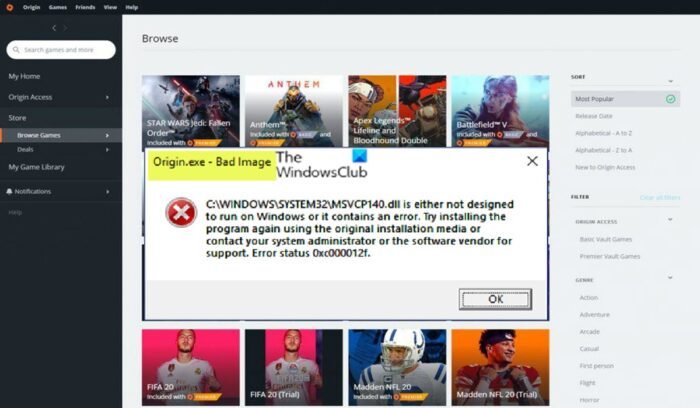
When you encounter this issue, you’ll receive the following full similar error message along the following lines;
Origin.exe – Bad Image
C:\WINDOWS\SYSTEM32\<NameOfDLLFile> is either not designed to run on Windows or it contains an error. Try installing the program again using the original installation media or contact your system administrator or the software vendor for support. Error status 0xc000012f.
Origin.exe Bad Image Error
If you get the Origin.exe Bad Image Error 0xc000012f when you try to open, install/uninstall the Origin client or a particular game on your Windows 11/10 gaming PC, you can try our recommended solutions below in no particular order and see if that helps you resolve the issue.
- Initial checklist
- Run Origin.exe with admin privilege
- Run the Program Install Uninstall Troubleshooter
- Re-register or Replace/Restore the DLL file
- Enable/Re-register Windows Installer Service
- Check your security software
- Repair/Update/Reinstall Visual C++ Redistributable
- Reinstall the Origin client or the game
Let’s take a look at the description of the fixes presented above.
1] Initial checklist
Before you proceed with the fixes below, since the Bad Image issue is commonly due to corrupt system files, you can quickly run an SFC scan and see if that helps. You may have to follow up with the DISM scan if need be. Also, make sure to check for Windows updates and install any newly available bits on your computer. On the other hand, if the error started after a recent Windows update as reported by some affected users, you can perform System Restore or uninstall the update – but if you prefer to try either as a last resort, you can then go ahead with the solutions below.
Read: Bad Image, D3D11.dll is not designed to run on Windows, Error 0xc0000020
2] Run Origin.exe with admin privilege
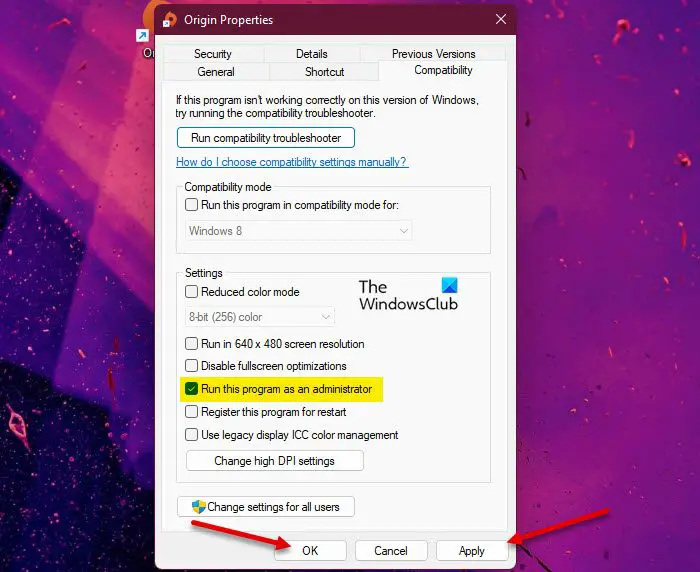
If the initial checklist wasn’t applicable, your next line of action to troubleshoot the Origin.exe Bad Image Error that has occurred on your Windows 11/10 gaming rig, is to make sure you run Origin.exe as administrator. To perform this task, do the following:
- Navigate to the Origin client or game installation folder on your local drive.
- At the location, right-click on the Origin.exe file.
- Choose Run as administrator from the context menu.
- Click Yes on the UAC prompt to confirm the process.
Now see if the error prompt reappears. If so, try the next solution.
Read: How to grant or get Elevated Privileges in Windows 11/10
3] Run the Program Install and Uninstall Troubleshooter
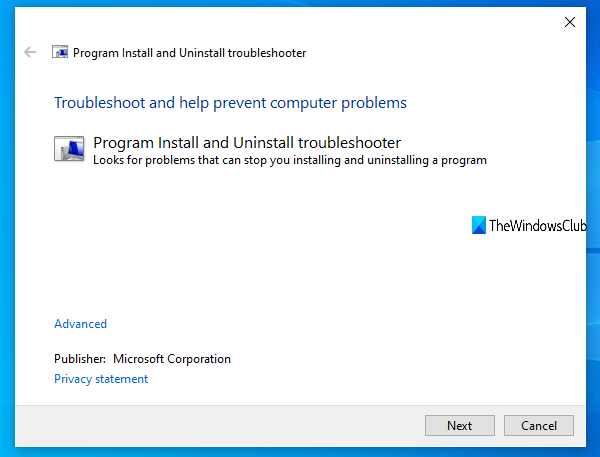
This fix is applicable if you get the error prompt when you try to install/uninstall the Origin client or a particular game on your Windows 11/10 gaming rig. The Program Install and Uninstall Troubleshooter will fix corrupted registry keys and is designed to help PC users automatically repair issues when blocked from installing or removing programs on Windows 11/10 system. This solution requires you to run Program Install and Uninstall Troubleshooter from Microsoft and see if the issue at hand is resolved. Otherwise, try the next solution.
Read: DLL is either not designed to run on Windows or it contains an error
4] Re-register or Replace/Restore the DLL file
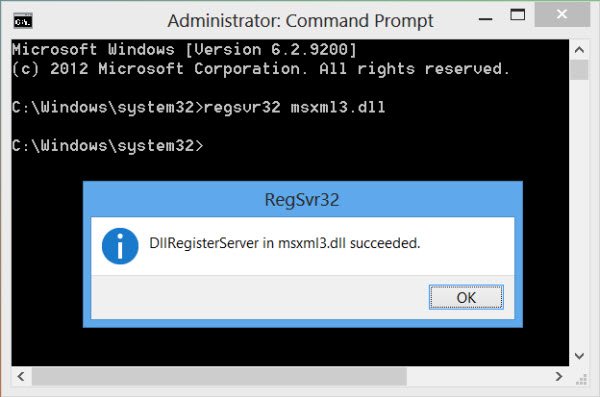
DLL files are system files and can be native to the Windows operating system or from a third party, usually installed along with a program or game. As we have identified the DLL file that could be missing, corrupt or damaged, this solution requires you to re-register the DLL file or replace/restore the file.
You can replace these files by visiting Winbindex and searching and downloading the file, then copying the file to the exact location shown on the error prompt – you can also move the file to the application or game installation folder. Most native .dll files can be found at this service which allows users to see the information about Windows 11/10 OS files and download them from Microsoft servers. Alternatively, you can copy the DLL file from a recently updated and working Windows PC.
5] Enable/Re-register Windows Installer Service
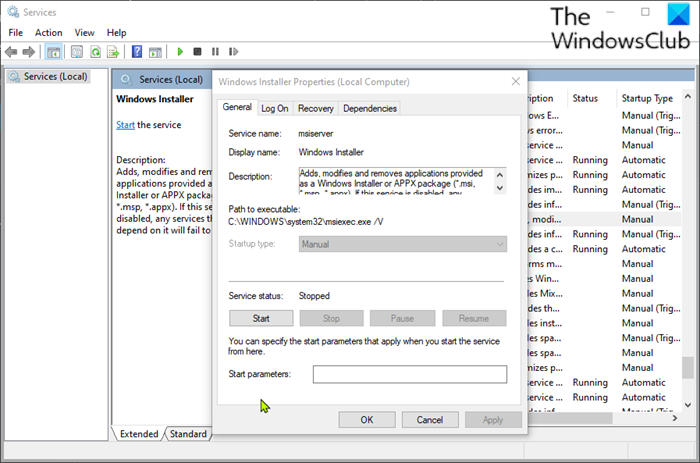
If the Windows modules installer isn’t running on the system you may encounter the error in view when you try to install/uninstall the Origin client or any game. This service handles installing system modules from applications, so without it running, there’s a chance that essential components aren’t installed. So, to rule out this possibility as a potential culprit, you need to ensure that the Windows Installer Service is enabled. However, if the service is running but the issue persists, you can unregister and re-register Windows Installer Service. Here’s how:
- Press Windows key + R to invoke the Run dialog.
- In the Run dialog box, type cmd and then press CTRL + SHIFT + ENTER to open Command Prompt in admin mode.
- In the command prompt window, type the command below and hit Enter to temporarily unregister the Windows Installer service:
msiexec /unreg
- Once the command is processed successfully and you get the success message, input the following command and hit Enter to register the Windows Installer once again:
msiexec /regserver
Once the second command executes, restart your computer. On boot, see if the error reoccurs. If so, try the next solution.
6] Check your security software
In some cases, it’s known for antivirus software to flag as suspicious or harmful and then quarantine DLL files, especially from third-party apps and games, hence the error in view because the file is presumed ‘missing’ so the program or game will be unable to call the DLL file to completely execute a task.
In this case, to rule out the possibility of your security software interference, you can check quarantined items and restore the file if that’s the case. Otherwise, try the next solution.
Read: Manage Quarantined Items, Exclusions in Windows Defender
7] Repair/Update/Reinstall Visual C++ Redistributable
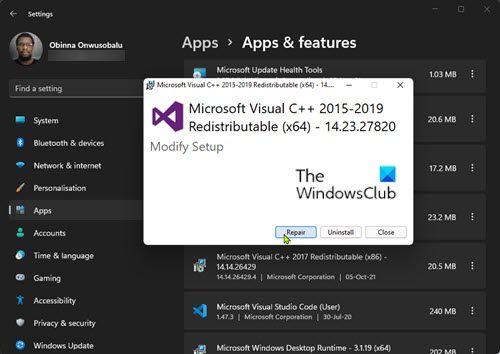
This solution requires you to repair, update, or reinstall Visual C++ Redistributable on your Windows 11/10 gaming PC. You can download and install the latest version of the Microsoft Visual C++ Redistributable package. You can repair the Visual C++ Redistributable via the Settings app – do the following:
- Open the Settings app.
- Click Apps on the left navigation pane.
- Now, scroll down on the Apps & features right pane.
- Click the ellipsis (three vertical dots) for the problematic Visual C++ Redistributable.
- Select Modify.
- Click Repair.
- Follow the on-screen instructions to finish the repair operation.
Alternatively, you can repair the Visual C++ Redistributable via Programs and Features on your Windows 11/10 computer by following the instructions in this guide OR you can repair/reinstall the package via the game installation folder – here’s how:
- Go to your game’s installation path via File Explorer.
- Open the _Installer folder.
- Open the VC folder.
- If there is only one folder in there, open it and continue with the next three steps below.
- If there are multiple folders, open the older one first. The folders are named by years, so if you see a vc2013 and a vc2015 folder, open vc2013 first. Follow the next three steps for the older folder, then repeat those two steps for the newer one.
- Open the redist folder.
- In the open folder, find both the x86 and x64 versions of vcredist.exe.
- Run each to install.
After you install/repair both versions of vcredist.exe, your game or the Origin client as the case may be, should launch without that error. Otherwise, try the next solution.
8] Reinstall the Origin client or the game
This solution requires you to reinstall the Origin client or the game that’s triggering this error. We recommend using any free third-party Uninstaller Software, then make sure to download and install the latest version of Origin client or the game as the case may be. If reinstalling didn’t help, you can reset Windows 11/10 and make sure to choose the Keep my files option. This option will essentially perform a fresh install of Windows while keeping all your data/files intact but will remove non-native apps and programs. After the reset procedure completes successfully, you can reinstall your games.
Hope this post helps you!
These posts might interest you:
- Fix WINWORD.EXE Bad Image error on Windows 11/10
- Fix Bad Image Error Status 0xc0000006 on Windows 11/10
- Fix Bad Image, Error Status 0xc0000020 on Windows 11/10
- Fix MSTeams.exe Bad Image Error Status 0xc0000020 in Windows 11/10
Why does my PC keep saying bad image?
A bad image error is when you try to launch a Windows program, but it does not launch properly. The reason for that is that the files or the libraries needed to run the program might be corrupted, or the process is interrupted, leading the user to face a bad image error.
How do I fix setup exe bad image error?
To fix the Bad Image error on Windows 11/10, you can try the following suggestions:
- Reinstall the program that can’t be opened
- Uninstall the problematic Windows update
- Run a System File Checker to check corrupted system file
- Run Windows Automatic Repair
- Perform a System Restore
Read: Fix AcroCEF/RdrCEF.exe Application or Bad Image Errors
What is the cause of bad Image?
Bad Image errors is an error that comes up when Windows cannot run the programs you tried running mainly due to the files and libraries needed to run the program being corrupted due to an update. In this case, uninstalling the ‘problematic’ update can resolve the issue.
How do I fix error 0xc000012f?
The Bad Image 0xc000012f error means some of the system files are corrupt and there are interfering with the system process. To fix the Bad Image error, you can apply the following fixes:
- Reinstall the problematic software
- Perform System Restore
- Rollback Windows Update
- Do a Clean Boot
- Run System File Checker
Also read:
- How to fix Bad Image Error Status 0xc000012f in Windows
- Fix Chrome.exe Bad Image, Error status 0xc000012f
Is a file ending in exe a virus?
A .exe file can be a virus, but that is certainly not true for all of them. Most are safe to use or even necessary for your Windows system to run. In cases when in doubt, you can run a full system AV scan or you can upload the file to VirusTotal, a service that analyzes suspicious files and URLs.
Leave a Reply